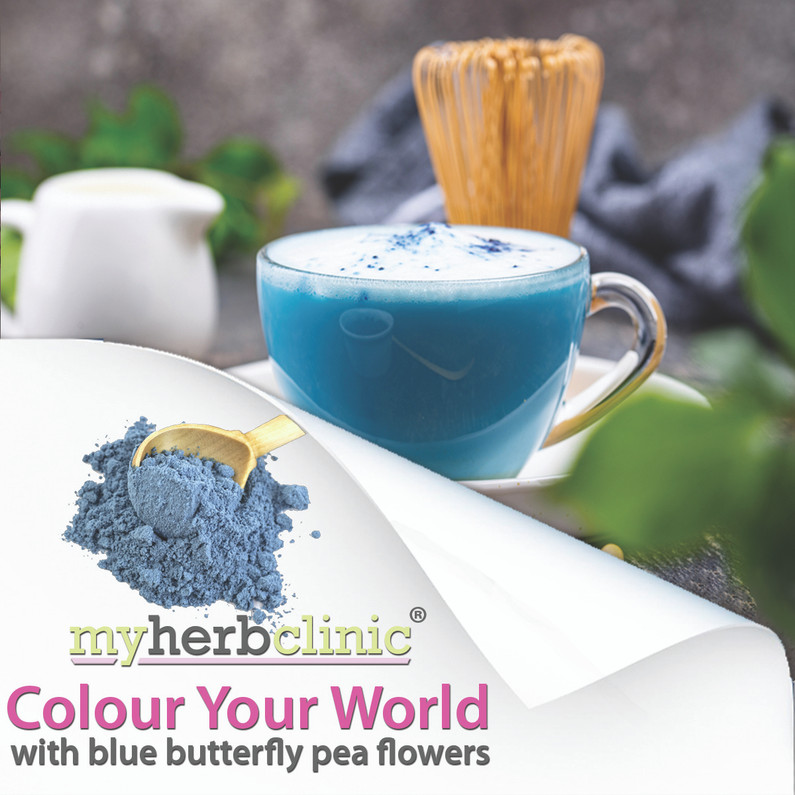Colour Your World - with Blue Butterfly Pea Flowers
Blue Butterfly Pea Powder is a naturally occurring rich blue in colour, thanks to the antioxidant content, that can be used to make vibrant drinks like Blue Matcha, or add a rich blue hue to your baking and raw cakes and desserts, and it isn't just a pretty face, it has a long history of use as a traditional medicine, and emerging research reveals the possible health benefits!
It is important to note however, that it is not considered one of the safe herbs to have during pregnancy. The list of pregnancy safe herbs is very small due to the problems around confirming safety without exposing anyone to risk.
Botanical Name: Clitoria ternatea
Flavour: mild and subtle earthy flavour. The taste is easily masked with other herbs, honey or lemon if you only desire to use as a natural colouring agent.
There is a long history of use in countries like Thailand, Vietnam and India. In fact, it is a popular Ayurvedic remedy for depression, anxiety, and memory. It is known by a few names including, Shankhpushpi, Sangu Pushpam, Sangu Poo, Aparajita, Bengali, Anchan, and Blue Pea Flower.
Research available on the web
There have been quite a few studies on the effects and health benefits of Clitoria ternatea (studies are cited below), showing that it has Nootropic, Anxiolytic, Antidepressant, Anti-ulcer, Anti-Stress, and Anticonvulsant action, with action appearing to effect and modulate behavior mediated by serotonin and acetylcholine pathways. It has also been researched for it's impact on diabetes and blood sugar regulation, and the rich antioxidant content.
Several secondary metabolites have been isolated from Blue Butterfly, which may be responsible for the herbal actions, including triterpenoids, flavonol glycosides, anthocyanins and steroids. These secondary metabolites may be responsible for the following actions: antimicrobial, antipyretic, anti-inflammatory, analgesic, diuretic, local anesthetic, antidiabetic, insecticidal, platelet aggregation inhibiting, and vascular smooth muscle relaxant.
Jain et al. showed in their animal study in 2003 that an extract of Clitoria ternatea could modulate induced behaviours that impacted the Serotonin and Acetylcholine pathways, while there was no significant change to Dopamine or Noradrenaline mediated behaviours. They documented evidence of nootropic, anxiolytic, antidepressant, anticonvulsant and antistress actions, without isolating any specific individual constituents that may be responsible for these effects.
Taranalli et al. found in their rat study that an extract of Clitoria ternatea increased the concentration of acetylcholine content and activity of acetyl cholinesterase in the brain, in a similar way to the cerebro-protective pharmaceutical, Pyritinol. Another study by Rai et al. supports this evidence with their rat study, showing increased acetylcholine in the hippocampus following administration of the extract, which resulted in improved memory and learning in the test subjects.
There may be an antihyperglycaemic effect as well, which basically means an effect that reduces the incidence of high blood sugar, possibly by reducing blood sugar levels through inhibition of absorption of sugar, or by increasing insulin levels. A rat study by Daisy & Rajathi, showed that the blood sugar levels were significantly reduced, as was the glycolated haemoglobin, gluconeogenic enzyme, and glucose-6-phosphatase. There was increased serum insulin, which may account for these results.
A further study by Daisy, Santosh & Rajathi, again investigating the antidiabetic effects of Clitoria ternatea, but also the impact on cholesterol, showed the same results of improved blood sugar levels, and increased insulin, and it also appeared to reduce total cholesterol, triglycerides, urea, and creatinine, while increasing HDL cholesterol (sometimes referred to as your 'good' cholesterol, though referring to cholesterol as good or bad is a bit inaccurate, it is more about the balance of LDL and HDL).
In addition to increasing insulin levels, there is evidence to suggest that Clitoria ternatea may be able to aid in regeneration of the pancreatic β-cells. Verma et al. found that there was an improvement in islet size and distribution, whether this was due to the treatment directly, or the antioxidant effect, paired with improved blood sugar control, reducing the stress on and damage caused to the pancreas.
Fun Stuff
If you want to avoid artificial colours and flavourings, Blue Butterfly Pea Flower Powder is the best way to achieve a gorgeous Royal Blue colour, or added to dairy and dairy substitutes, a beautiful lighter blue.
If you really want to get creative, this stunning powder has become a popular ingredient in funky and fresh cocktails, or to make a magical colouring changing lemonade - old school with real lemons of course.
Why do real lemons cause a magical colour changing effect? Well that is because the blue antioxidant pigment goes through a chemical change when it is exposed to citric acid, and it magically turns purple! If you swish the blue liquid into your homemade lemonade, or sparkling water with a slice of fresh lemon, you get the amazing blue and purple colour changing effect.
This is a great interactive science experiment to do with the kids at home too! Plus you get to enjoy a refreshing drink at the end ![]()
It has also been traditionally used to colour rice blue in asian desserts, and you could make fun coloured rice and pasta for exciting kids dinners!
Whether you are after sophisticated beverages, snacks and desserts, or fun and funky kid friendly drinks and food, this powder is certainly versatile!
References:
Al-Snafi, A. E. (2016). Pharmacological importance of Clitoria ternatea–A review. IOSR Journal of Pharmacy, 6(3), 68-83.
Chayaratanasin, P., Barbieri, M. A., Suanpairintr, N., & Adisakwattana, S. (2015). Inhibitory effect of Clitoria ternatea flower petal extract on fructose-induced protein glycation and oxidation-dependent damages to albumin in vitro. BMC complementary and alternative medicine, 15(1), 1-9.
Daisy, P., & Rajathi, M. (2009). Hypoglycemic effects of Clitoria ternatea Linn.(Fabaceae) in alloxan-induced diabetes in rats. Tropical Journal of Pharmaceutical Research, 8(5).
Daisy, P., Santosh, K., & Rajathi, M. (2009). Antihyperglycemic and antihyperlipidemic effects of Clitoria ternatea Linn. in alloxan-induced diabetic rats. Afr J Microbiol Res, 3(5), 287-291.
Gollen, B., Mehla, J., & Gupta, P. (2018). Clitoria ternatea Linn: A Herb with potential pharmacological activities: Future prospects as therapeutic Herbal Medicine. J Pharma Reports, 3(1), 1-8.
Gupta, G. K., Chahal, J., & Bhatia, M. (2010). Clitoria ternatea (L.): Old and new aspects. J Pharm Res, 3(11), 2610-2614.
Jain, N. N., Ohal, C. C., Shroff, S. K., Bhutada, R. H., Somani, R. S., Kasture, V. S., & Kasture, S. B. (2003). Clitoria ternatea and the CNS. Pharmacology Biochemistry and Behavior, 75(3), 529-536.
Mukherjee, P. K., Kumar, V., Kumar, N. S., & Heinrich, M. (2008). The Ayurvedic medicine Clitoria ternatea—From traditional use to scientific assessment. Journal of ethnopharmacology, 120(3), 291-301.
Rai, K. S., Murthy, K. D., Karanth, K. S., Nalini, K., Rao, M. S., & Srinivasan, K. K. (2002). Clitoria ternatea root extract enhances acetylcholine content in rat hippocampus. Fitoterapia, 73(7-8), 685-689.
Taranalli, A. D., & Cheeramkuzhy, T. C. (2000). Influence of Clitoria ternatea extracts on memory and central cholinergic activity in rats. Pharmaceutical biology, 38(1), 51-56.
Verma, P. R., Itankar, P. R., & Arora, S. K. (2013). Evaluation of antidiabetic antihyperlipidemic and pancreatic regeneration, potential of aerial parts of Clitoria ternatea. Revista Brasileira de Farmacognosia, 23(5), 819-829.
Recent Posts
-
Natural Remedies for Better Sleep: Top Herbal Teas
In today’s fast-paced world, achieving a good night’s sleep can often feel like an elusi …15th Jul 2025 -
The Benefits of Aromatherapy with Essential Oils: A Natural Path to Wellness
Aromatherapy is a centuries-old practice that uses the power of natural plant extracts, known as ess …8th Jul 2025 -
How to Choose Essential Oils for Beginners: A Simple Guide
How to Choose Essential Oils for Beginners: A Simple Guide Essential oils have become increasingly p …7th Jul 2025




